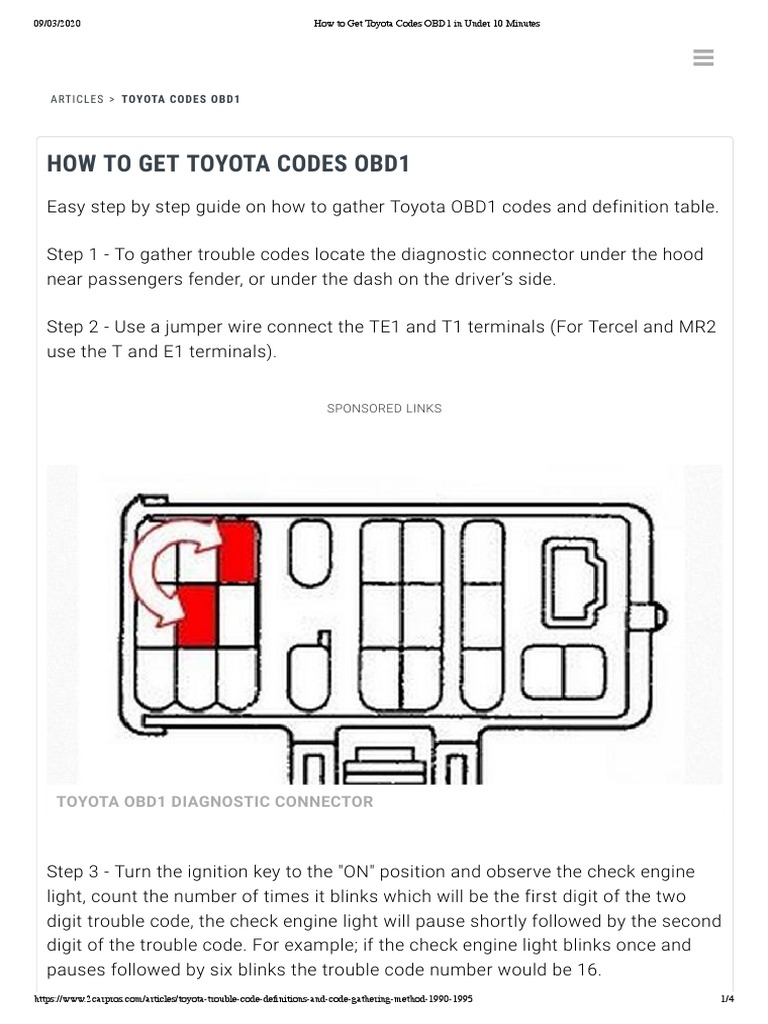Toyota OBD1 diagnostic systems, found in vehicles manufactured roughly before 1996, use simple flashing patterns to indicate trouble codes. Understanding these codes is the first step in troubleshooting issues.
Reading Toyota OBD1 Codes
The Check Engine Light (CEL) blinks to display codes:
- Locate the Diagnostic Connector: Find the small rectangular port, often labelled DIAGNOSTIC, typically under the hood near the engine ECU or fuse box.
- Initiate Diagnostic Mode: Use a jumper wire or paperclip to bridge terminals E1 (Ground) and TE1 (or T) on this connector. Turn the ignition key to "ON" (engine not running).
- Watch the CEL Flashes: The CEL will blink, indicating codes.
Interpreting the Flashes
- The CEL flashes long blinks (about 0.6 seconds) for the first digit of a code.
- It flashes short blinks (about 0.3 seconds) for the second digit.
- A pause of about 1.5 seconds separates the digits of a single code.
- A longer pause (about 2.5 seconds) separates different codes if multiple are stored.
- Code "12" is always flashed first when entering diagnostic mode (indicates system working).
- Codes are repeated several times. The sequence ends with Code "12" again.
Common Toyota OBD1 Codes and Meanings
Note: Code definitions can vary slightly depending on the specific engine (4A-FE, 3S-GTE, 5VZ-FE, etc.) and model year. Always consult the vehicle's Factory Service Manual (FSM) for absolute precision.

| Code Number | System Affected | Potential Causes | Severity |
|---|---|---|---|
| 12 | RPM Signal | No NE (RPM) signal to ECU within first 2 seconds after engine start. Often the initial system check signal. | Information / Initial Check |
| 13 | RPM Signal | No NE signal to ECU above 1000 RPM. Faulty circuit, distributor pickup, ECU. | Moderate-High (Engine won't run or runs poorly) |
| 14 | Ignition Signal (IGF) | No ignition confirmation (IGF) signal to ECU after 6-10 consecutive IGT pulses. Igniter circuit fault. | High (Engine likely stalls or won't start) |
| 21 | Oxygen Sensor (A/F Sensor) | Heated Oxygen Sensor circuit fault (Main sensor bank 1). Sensor heater, wiring, sensor itself. | Low-Moderate (Affects fuel trim, MPG, emissions) |
| 22 | Coolant Temp Sensor | Engine Coolant Temperature (ECT) sensor circuit fault (short or open). Wiring, connector, sensor failure. | Moderate (Poor running, starting issues, rich/lean) |
| 24 | Intake Air Temp Sensor | Intake Air Temperature (IAT) sensor circuit fault. Wiring, connector, sensor failure. | Low-Moderate (Minor fuel trim adjustments) |
| 25 | Air/Fuel Ratio Lean | System consistently too lean (Bank 1). Vacuum leaks, low fuel pressure, faulty MAF/VAF, O2 sensor. | Moderate (Poor performance, hesitation, high emissions) |
| 26 | Air/Fuel Ratio Rich | System consistently too rich (Bank 1). Injector leak, high fuel pressure, faulty MAF/VAF, O2 sensor, coolant temp sensor. | Moderate (Poor MPG, rough idle, smell, high emissions) |
| 27 | Secondary O2 Sensor | Sub Oxygen Sensor circuit fault (bank 1, usually after catalytic converter). Sensor heater, wiring, sensor. | Low (Primarily affects catalytic converter monitoring) |
| 28 | Oxygen Sensor (Bank 2) | Main O2 Sensor circuit fault (Bank 2, in V6/V8 engines). Sensor heater, wiring, sensor. | Low-Moderate |
| 31 | Mass/Vane Air Flow Meter | Mass Air Flow (MAF) or Vane Air Flow (VAF) meter circuit fault. Wiring, connector, MAF/VAF sensor failure. | Moderate-High (Affects fuel/air metering) |
| 41 | Throttle Position Sensor | Throttle Position Sensor (TPS) circuit fault. Wiring, connector, TPS adjustment/sensor failure. | Moderate (Idle, shifting, throttle response issues) |
| 42 | Vehicle Speed Sensor | Vehicle Speed Sensor (VSS) circuit fault. Sensor, wiring, instrument cluster fault. | Low (Affects shifting on autos, cruise control, speedo) |
| 43 | Starter Signal | No STA (Starter) signal to ECU during cranking. Starter circuit, ignition switch, wiring. | High (Engine cranks but won't start) |
| 51 | Switch Signal (A/C, Neutral/PNS) | Problem with signals from A/C switch or P/N switch (Auto Transmission). Switch, wiring. | Low (May affect idle control) |
| 52 | Knock Sensor (Bank 1) | Knock Sensor #1 circuit fault. Sensor, wiring. Common failure on older Toyotas. | Low-Moderate (ECU defaults to safe ignition timing, slight power loss) |
| 55 | Knock Sensor (Bank 2) | Knock Sensor #2 circuit fault (Bank 2, V6/V8 engines). Sensor, wiring. | Low-Moderate |
| 71 | ECU Back-up Power | Loss of backup power to ECU (+B terminal). Bad EFI main relay, blown fuse, wiring fault. | Moderate (Can cause memory loss - radio presets, idle learn, etc.) |
After Retrieving Codes
- Write Them Down: Record all displayed codes besides the initial and final 12.
- Clear ECU Memory: To confirm a fix and turn off the CEL, clear codes after diagnosis by removing the EFI fuse (or ECU-B fuse, check FSM) for 30-60 seconds, or disconnecting the battery negative terminal for the same duration. Note: This may also reset radio presets and the idle learning process (car may idle roughly for a few minutes after restart).
- Diagnose the Root Cause: A trouble code points to a circuit or system. It doesn't automatically mean the sensor is bad. Check wiring, connectors, fuses, and vacuum lines related to that system before replacing components. Consult the specific diagnostic flow for the code in the Factory Service Manual.
Important: OBD1 systems are simpler but require manual retrieval and interpretation. They lack the detailed standardized definitions of OBD2. Referencing the correct Factory Service Manual for your specific Toyota model and year is crucial for accurate diagnosis.
